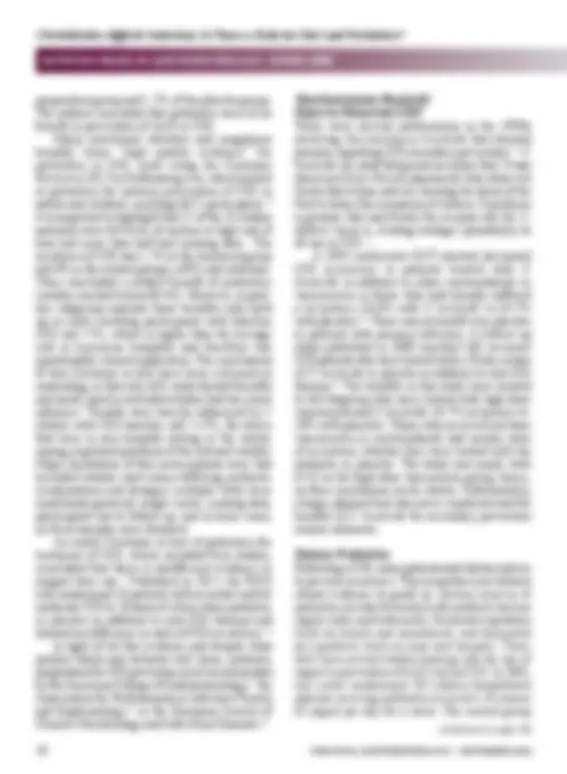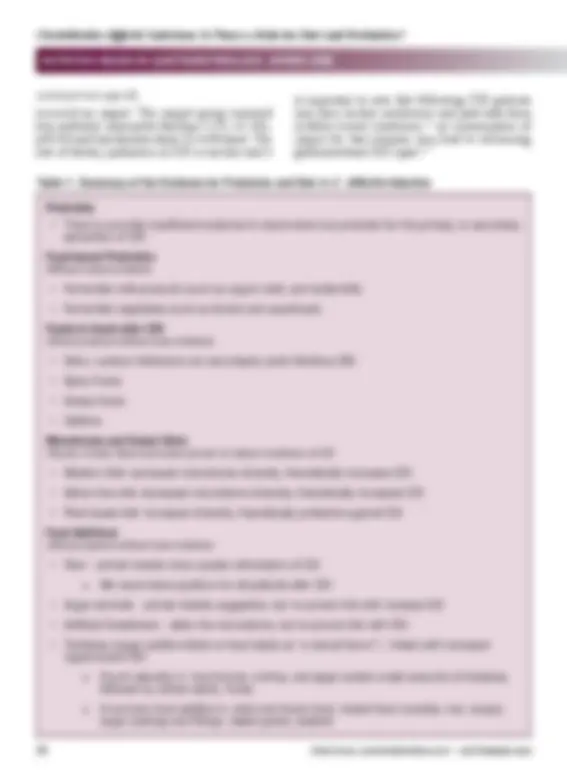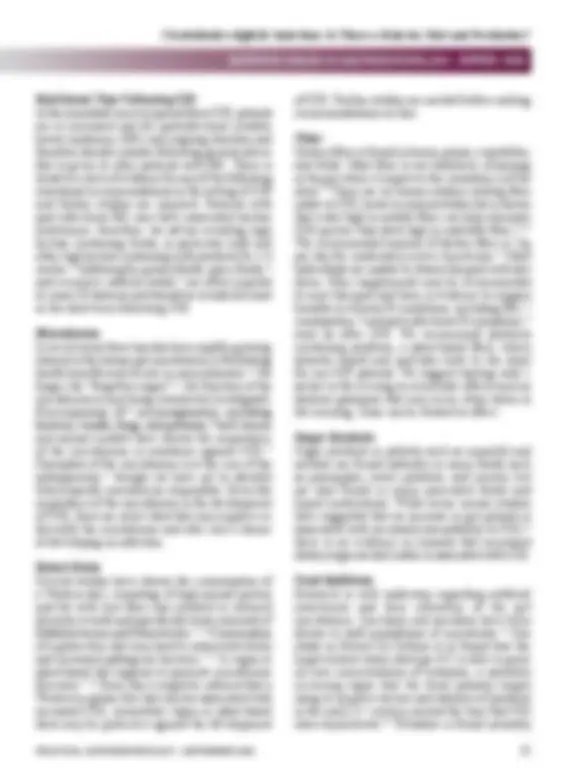





Study with the several resources on Docsity

Earn points by helping other students or get them with a premium plan


Prepare for your exams
Study with the several resources on Docsity

Earn points to download
Earn points by helping other students or get them with a premium plan
Community
Ask the community for help and clear up your study doubts
Discover the best universities in your country according to Docsity users
Free resources
Download our free guides on studying techniques, anxiety management strategies, and thesis advice from Docsity tutors
An in-depth analysis of the role of diet and probiotics in preventing and treating Clostridioides difficile Infection (CDI). the increase in CDI between 2000 and 2010, the potential causes, and the limitations of probiotic use. It also explores the use of Saccharomyces boulardii, dietary probiotics, and specific foods and diets in relation to CDI. The document concludes that while there is insufficient evidence to recommend any probiotic for the primary or secondary prevention of CDI, consuming a plant-based diet with increased dietary fiber may help increase microbiome diversity and potentially reduce the risk of CDI.
What you will learn
Typology: Exams
1 / 7

This page cannot be seen from the preview
Don't miss anything!




NUTRITION ISSUES IN GASTROENTEROLOGY, SERIES #
Christopher Ward Colleen R. Kelly
Clostridioides difficile is a spore forming bacterium leading to significant morbidity and mortality amongst hospitalized as well as non-hospitalized patients in the United States. While hospital acquired infections have reduced, in recent years we have seen an increase in community acquired infections. With the focus on antimicrobial therapies and fecal microbiota transplantation, it is important to understand the evidence behind probiotics and nutrition in the management of C. difficile infections. There is an abundance of new literature regarding the $40 billion a year probiotic industry, meanwhile patients require dietary advice following an infection. In this review, we aim to give the non-specialty clinician some clarity regarding these issues.
of CDI, as many cases occur without a history of antibiotic use.^2 There was a significant increase in CDI between 2000-2010, which has been attributed to increased detection with use of nucleic acid amplification testing, more virulent strains, and increased community antibiotic use. Since then, we have seen a reduction in healthcare associated CDI, though there are still almost half a million cases per year within the United States.^3 Infection control measures, decreased fluroquinolone use, and improved antibiotic stewardship have been credited with these results.^4 In recent years there has been an abundance of new literature on C. difficile with regards to management and prevention options. For the non- specialty clinician, it is challenging to determine which data is high quality and what can be applied to their patients. With the spotlight on fecal microbiota
INTRODUCTION
lostridioides difficile is an anaerobic, gram positive, spore forming bacterium that causes a spectrum of gastrointestinal symptoms ranging from mild diarrhea to colitis, toxic megacolon, intestinal perforation, and death. It is spread via the fecal-oral route and is frequently encountered in hospitals, affecting 1% of US hospital stays^1 and nursing homes where antibiotic use is common. Concerningly, community-acquired infections are common, and recent research suggests other undefined causes
NUTRITION ISSUES IN GASTROENTEROLOGY, SERIES #
ill patients leading to the recommendation that they be used with caution in immunocompromised patients and those with structural heart disease or central venous catheters.^11 Microbiome analyses have shown that they may actually impede normal recolonization in the gut after a course of antibiotics.^12 Despite this, probiotics are widely recommended by physicians to prevent CDI in patients being treated with antibiotics (primary prevention) or in patients being treated for CDI to prevent recurrences (secondary prevention). Costs range from $30 to $100 per month for the most commonly recommended formulations, which are frequently taken for extended courses and typically not covered by insurance. Given these costs, the desire to provide reliable health information to our patients, and the potential for harm, it is important to critically appraise data supporting the use of probiotics in CDI. Evidence to support probiotics in the management of CDI comes mainly from meta analyses, which pool data from smaller trials of variable probiotic formulations and methodologies. There is a paucity of high-quality clinical trial data of probiotics in CDI, and most studies are underpowered, with CDI as a secondary outcome in studies done to assess prevention of antibiotic associated diarrhea (AAD). A 2016 global review of guidelines, strategies, and recommendations for CDI prevention^4 labelled probiotics as an area of research, but were unable to recommend their use. There is currently insufficient evidence to recommend any probiotic for the primary or secondary prevention of CDI.
The Literature The PLACIDE trial is the largest double-blind clinical primary prevention randomized controlled trial (RCT) to date.^13 This multicenter trial in the United Kingdom enrolled nearly 3000 elderly inpatients who were at high risk of contracting CDI. Patients >65 years old receiving antibiotics were randomized to treatment with a multi-strain preparation composed of bifidobacterium and Lactobacillus acidophillus strains or placebo for 21 days. AAD including CDI occurred in 10·8% of the microbial preparation group and 10·4% of those treated with placebo. CDI was an uncommon cause of AAD and occurred in just 0·8% of the microbial
transplantation (FMT) and other non-antibiotic therapies for CDI, it is understandable that both clinicians and patients are seeking preventative options such as probiotics and nutrition. Here we evaluate the current evidence for these therapies in the prevention of CDI.
Probiotics Probiotics are defined as live microorganisms that, when administered in adequate amounts, confer a health benefit on the host.^5 The literal translation is “for-life”, which conveys that they are good, natural, and beneficial to biological functions. Proposed mechanisms for beneficial effects include modification of the gut microbiota, competitive adherence to the mucosa and epithelium, strengthening of the gut epithelial barrier, and modulation of the immune system to convey an advantage to the host.^6 Probiotics are marketed as dietary supplements with colourful labels and vague claims of “friendly bacteria” to “improve gut health.” This 40 billion dollar a year industry,^7 while extremely appealing to patients and healthcare professionals, operates without the strict oversight by the U.S. Food and Drug Administration that is required of drugs. A quick internet search reveals a plethora of websites recommending various probiotics as a means to improve one’s health for various indications, including after CDI. A 2010 survey of gastroenterologists found that 98% of respondents believed probiotics have a role in treating gastrointestinal illnesses or symptoms, despite the paucity of data to support their use. Sixty percent believed that the literature supported the use of probiotics in the treatment of CDI.^8 Due to the lack of regulation and freedom to make general health claims on product labels, there is little incentive for manufacturers to conduct clinical trials to support specific indications for their products.^9 The trouble with many of the available products is that quality control is often sub-optimal with inconsistencies and deviations from the information provided on the product label including misidentified, misclassified or non-viable strains, contaminated products, or diminished functional properties.^10 The belief that probiotics “can’t hurt” has been challenged by case reports of bloodstream infections with probiotic organisms in critically
NUTRITION ISSUES IN GASTROENTEROLOGY, SERIES # 202
received no yogurt. The yogurt group reported less antibiotic associated diarrhea (12% vs 24%, p=0.04) and less diarrhea days (23 vs 60 days). The role of dietary probiotics in CDI is unclear and it
is important to note that following CDI patients may have lactose intolerance and post-infectious irritable bowel syndrome,^24 so consumption of yogurt for that purpose may lead to worsening gastrointestinal (GI) upset.^25
Probiotics · There is currently insufficient evidence to recommend any probiotic for the primary or secondary prevention of CDI Food-based Probiotics
· Fermented milk products (such as yogurt, kefir, and buttermilk) · Fermented vegetables (such as kimchi and sauerkraut) Foods to Avoid after CDI
· Dairy: Lactose intolerance can accompany post-infectious IBS · Spicy Foods · Greasy foods · Caffeine Microbiome and Select Diets
· Western Diet: decreased microbiome diversity, theoretically increased CDI · Gluten free diet: decreased microbiome diversity, theoretically increased CDI · Plant based diet: increased diversity, theoretically protective against CDI Food Additives
· Fiber - animal models show quicker elimination of CDI. o We recommend psyllium for all patients after CDI · Sugar alcohols - animal models suggestive, but no proven link with increase CDI · Artificial Sweeteners - alters the microbiome, but no proven link with CDI · Trehalose (sugar additive listed on food labels as “a natural flavor”) - linked with increased hypervirulent CDI o Found naturally in: mushrooms, shrimp, and algae contain small amounts of trehalose, followed by certain seeds, honey o A common food additive in: dried and frozen food, instant food (noodles, rice, soups), sugar coatings and fillings, baked goods, seafood
Table 1. Summary of the Evidence for Probiotics and Diet in C. difficille Infection
NUTRITION ISSUES IN GASTROENTEROLOGY, SERIES #
Nutritional Tips Following CDI In the immediate recovery period from CDI, patients are at increased risk for postinfectious irritable bowel syndrome (IBS) and ongoing diarrhea and therefore should consider following general advice that is given to other patients with IBS. There is however a lack of evidence for any of the following nutritional recommendations in the setting of CDI and further studies are required. Patients with post infectious IBS may have associated lactose intolerance; therefore, we advise avoiding high lactose containing foods, in particular milk and other high lactose containing milk products for 2- weeks.^24 Additionally, greasy foods, spicy foods,^26 and excessive caffeine intake^27 are often reported to cause GI distress and should be avoided at least in the short-term following CDI.
Microbiome In recent years there has also been rapidly growing interest in the human gut microbiome in facilitating health benefits and its role in many diseases.^28 No longer the “forgotten organ”^29 , the function of the microbiome is now being extensively investigated. Encompassing 1014 microorganisms, including bacteria, viruses, fungi, and protozoa;^30 both human and animal models have shown the importance of the microbiome in resistance against CDI.^31 Disruption of the microbiome is at the core of the pathogenesis,^32 though we have yet to identify which specific microbes are responsible. Given the importance of the microbiome in the development of CDI, there are select diets that may improve or diversify the microbiome and alter one’s chance of developing an infection.
Select Diets Several studies have shown the consumption of a Western diet, consisting of high animal protein and fat with low fiber has resulted in reduced diversity overall and specifically lower amounts of Bifidobacterium and Eubacterium.33-34^ Consumption of a gluten free diet may lead to reduced diversity and increased pathogenic bacteria.35-36^ A vegan or plant-based diet appears to promote microbiome diversity.37-38^ From this it might be inferred that a Western or gluten free diet may be associated with increased CDI, meanwhile vegan or plant-based diets may be protective against the development
of CDI. Further studies are needed before making recommendations on this.
Fiber Dietary fiber is found in beans, grains, vegetables, and fruits. Most fiber is not absorbed, remaining in the gut where it improves the consistency of the stool.^39 There are no human studies relating fiber intake to CDI, however animal studies have shown that a diet high in soluble fiber can help eliminate CDI quicker than diets high in insoluble fiber.40- The recommended amount of dietary fiber is 25g per day for moderately active Americans.^43 Most individuals are unable to obtain this goal with diet alone. Fiber supplements may be recommended to meet this goal and there is evidence to support benefits in various GI conditions, including IBS,^39 constipation,^44 and post infectious GI symptoms,^45 such as after CDI. We recommend products containing psyllium, a plant-based fiber, which absorbs liquid and provides bulk to the stool for our CDI patients. We suggest starting with 1 sachet in the evening to avoid side effects such as daytime gassiness that may occur when taken in the morning. Dose can be titrated to effect.
Sugar Alcohols Sugar alcohols or polyols such as mannitol and sorbitol are found naturally in many foods such as pineapples, sweet potatoes, and carrots, but are also found in many processed foods and liquid medications. While some mouse studies have suggested that an increase in gut polyols is associated with increased susceptibility to CDI,^46 there is no evidence in humans that increased dietary sugar alcohol intake is associated with CDI.
Food Additives Research is well underway regarding artificial sweeteners and their alteration of the gut microbiome. Saccharin and sucralose have been shown to shift populations of microbiota.^47 One study in Nature by Collins et al found that the hypervirulent strain ribotype 027 is able to grow on low concentrations of trehalose, a naturally occurring sugar that the food industry began using to improve texture and stability of products in the early 21st^ century, around the time that CDI rates skyrocketed.^48 Trehalose is found naturally
NUTRITION ISSUES IN GASTROENTEROLOGY, SERIES # 202 NUTRITION ISSUES IN GASTROENTEROLOGY, SERIES #
1 2 3 4 5 6 7 8 9 10 11 12
13 14 15 16 17 18 19 20 21 22 23 24 25 26 27 28 29 30 31 32 33 34 35 36 37 38 39 40 41 42 43